Abstract
OBJECTIVE: To determine if body mass index (BMI) influences tumor expression of HER-2/neu, estrogen and progesterone receptors (ER/PR), and survival in women with endometrial adenocarcinoma. METHODS: Patients diagnosed between January 1992 and December 2001 with endometrioid adenocarcinoma of the uterus were identified. Clinical and pathologic data were retrospectively collected. HER-2/neu, estrogen and progesterone receptor expression were determined by immunohistochemistry. Differences in these variables and other prognostic factors were analyzed and correlated with effect on survival. RESULTS: One-hundred-sixty-five patients were included in this analysis. Lower BMI was associated with high stage (p=0.04) and HER-2/neu expression (p=0.04). Black race, high grade, high stage and lack of ER/PR expression were all associated with decreased survival. Despite having better prognostic factors, women with a BMI >25 had a lower survival than women with a BMI <25 (p=0.36). When five-year survival rates were calculated for BMI category and stratified by prognostic factors, for almost every high risk factor, survival was lower in overweight patients. CONCLUSION: In patients with endometrioid adenocarcinoma, low BMI is associated with high stage and tumor expression of HER-2/neu. Despite better prognostic factors, overweight women experience poorer survival.
Full text
PDF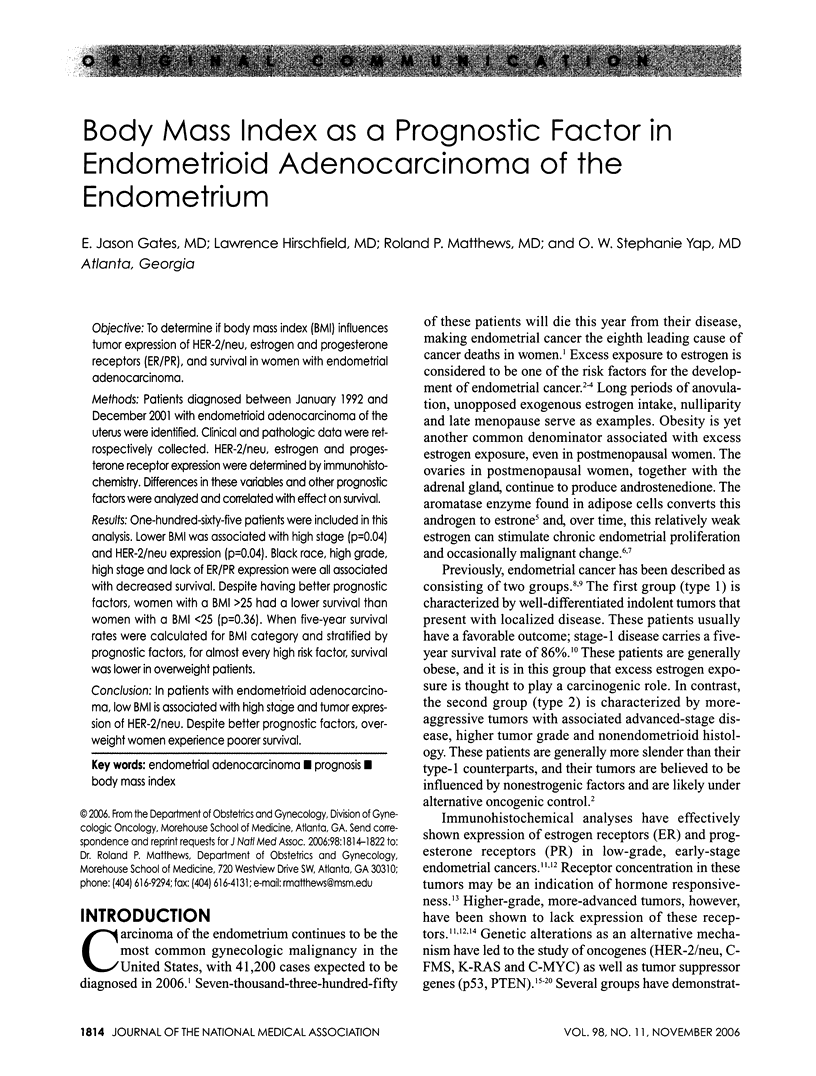
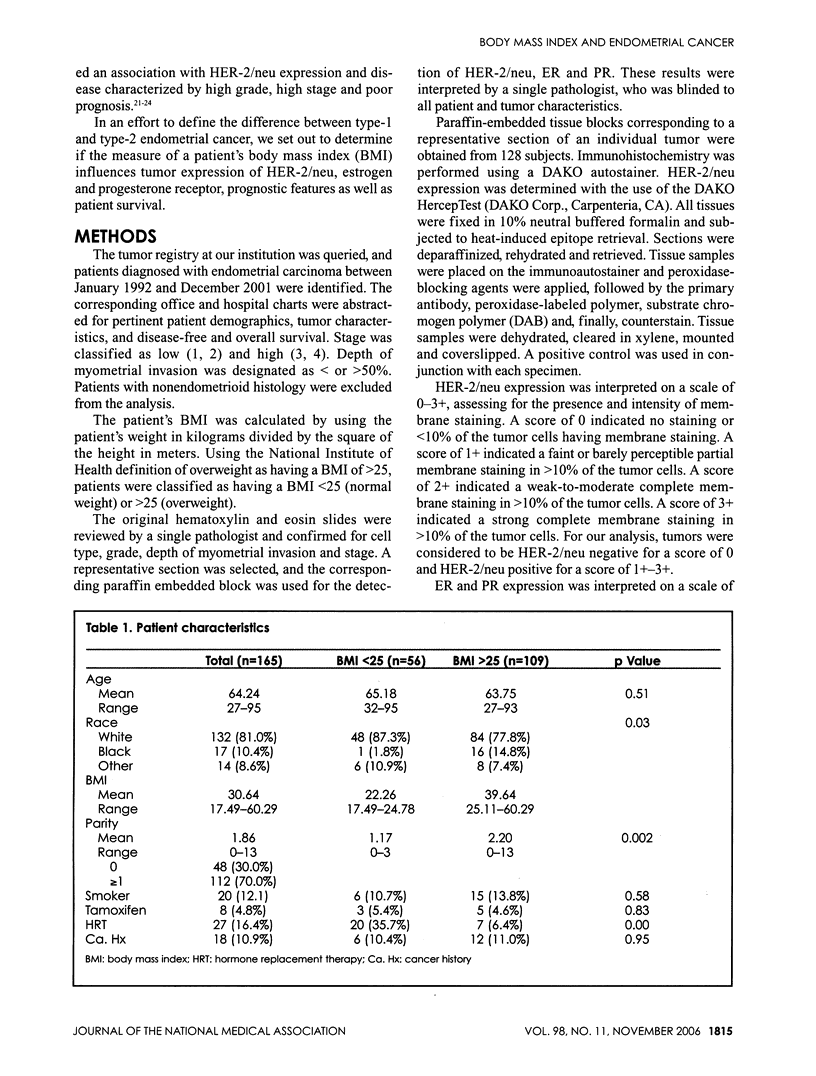
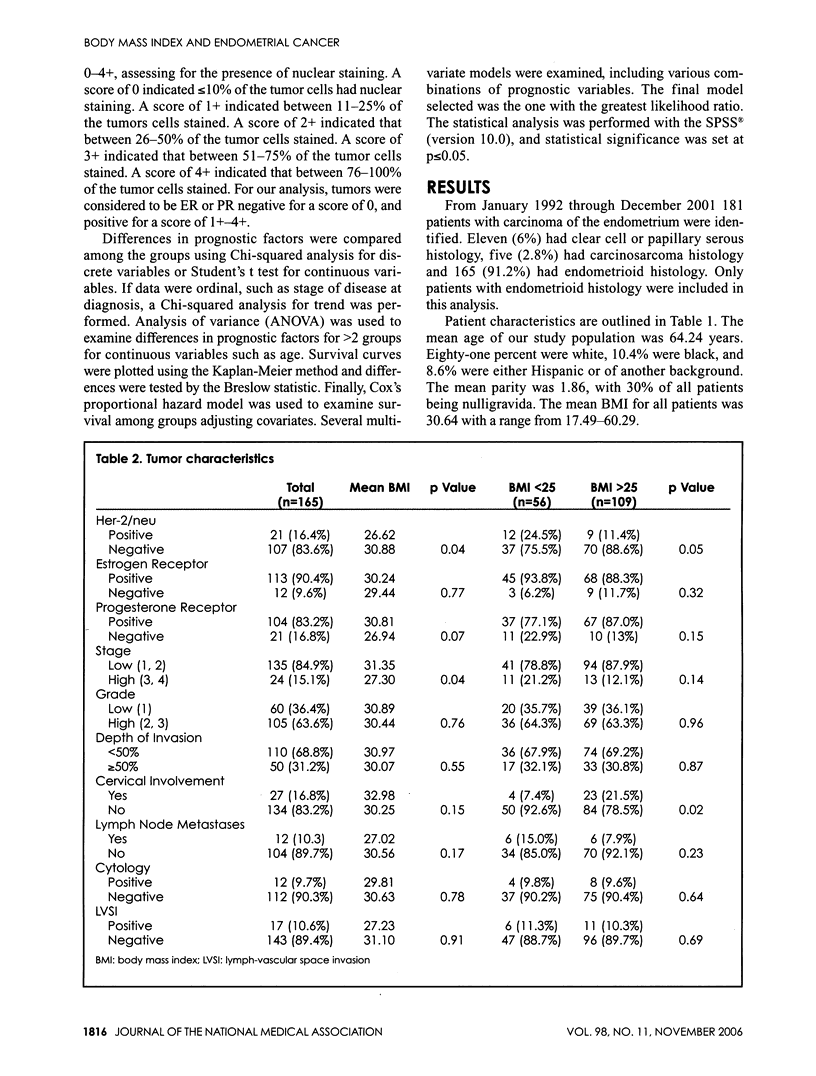
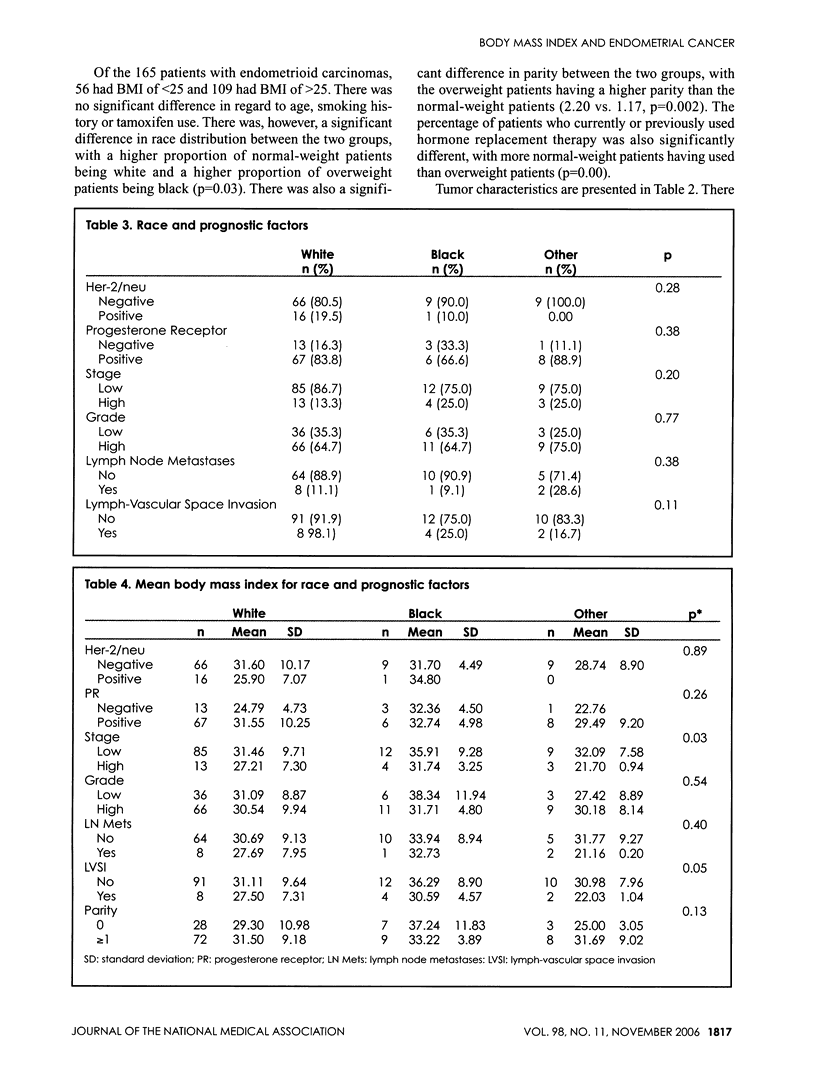
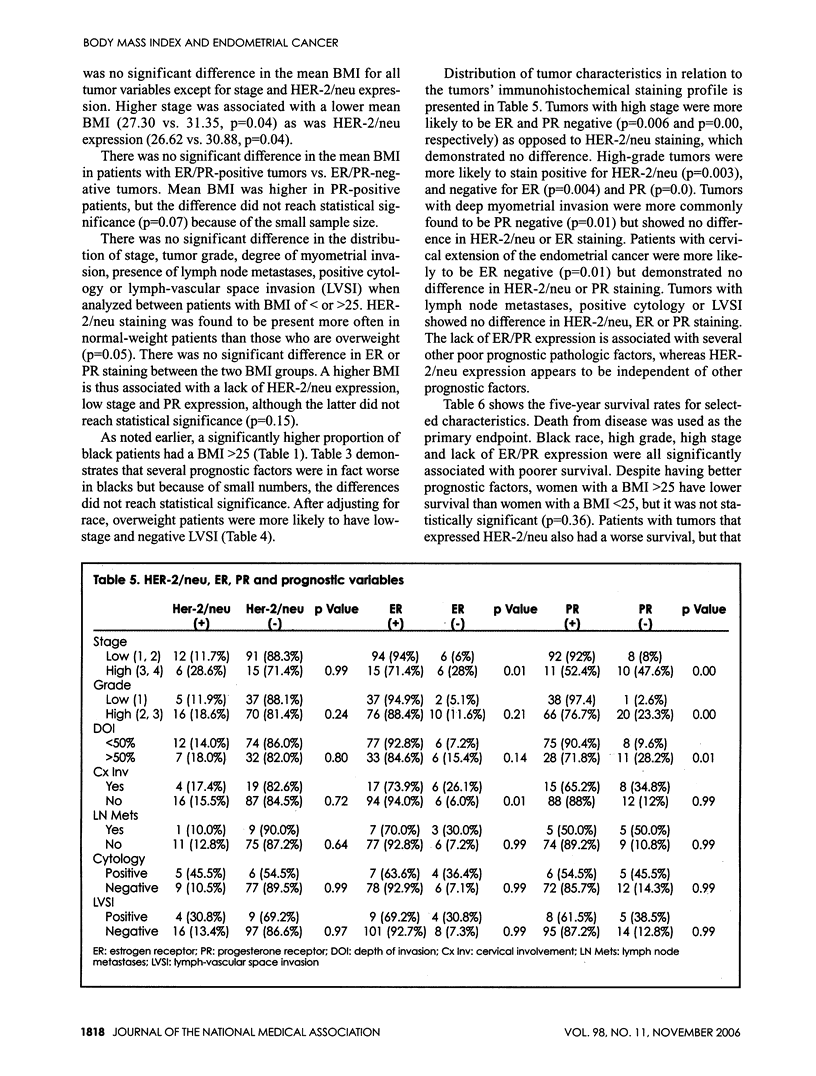
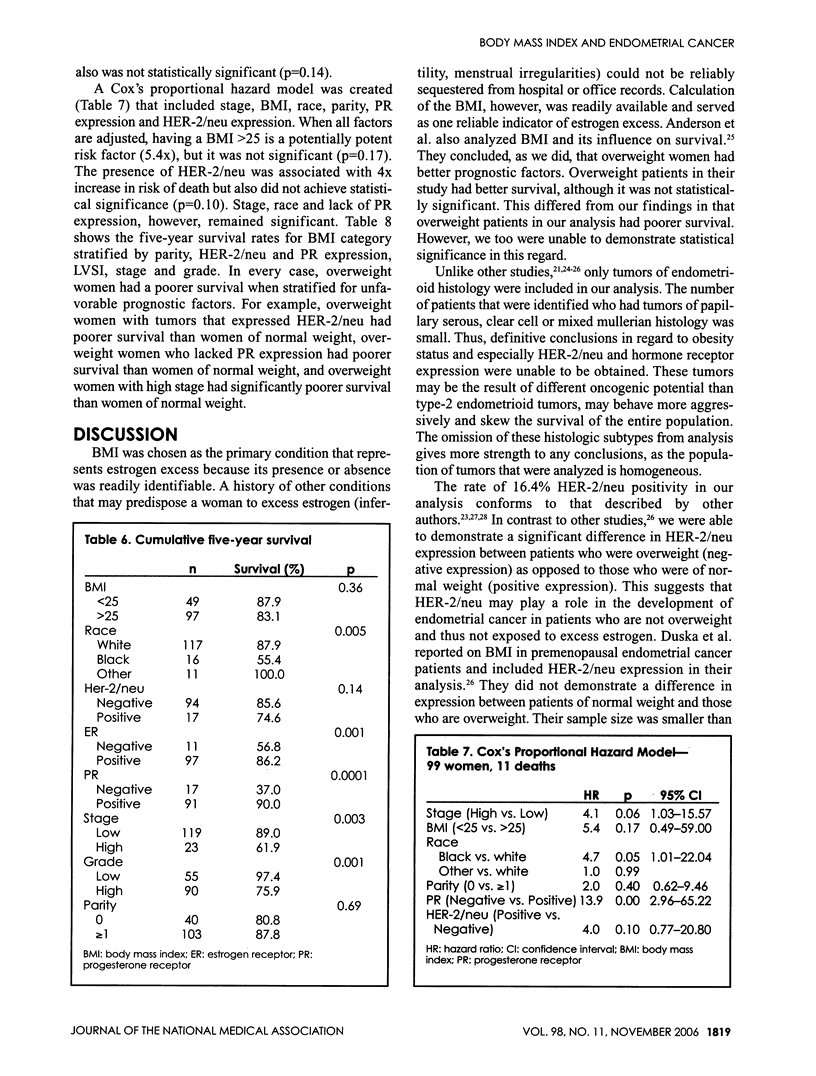
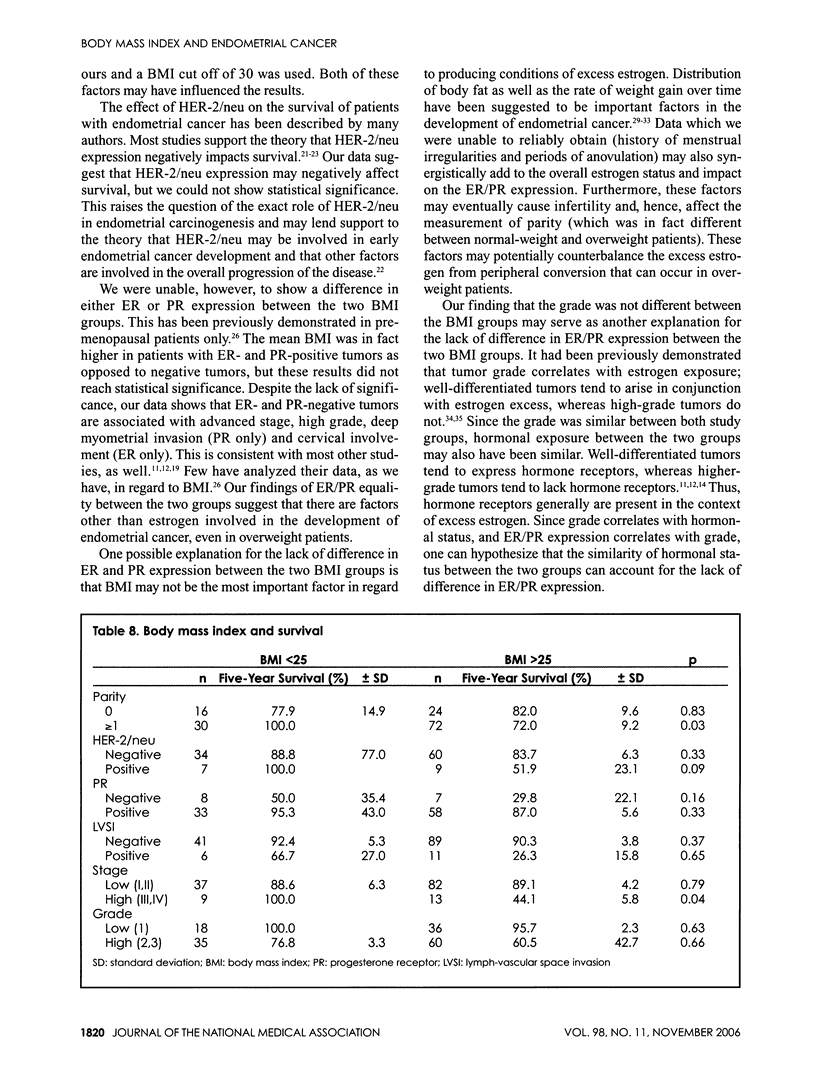
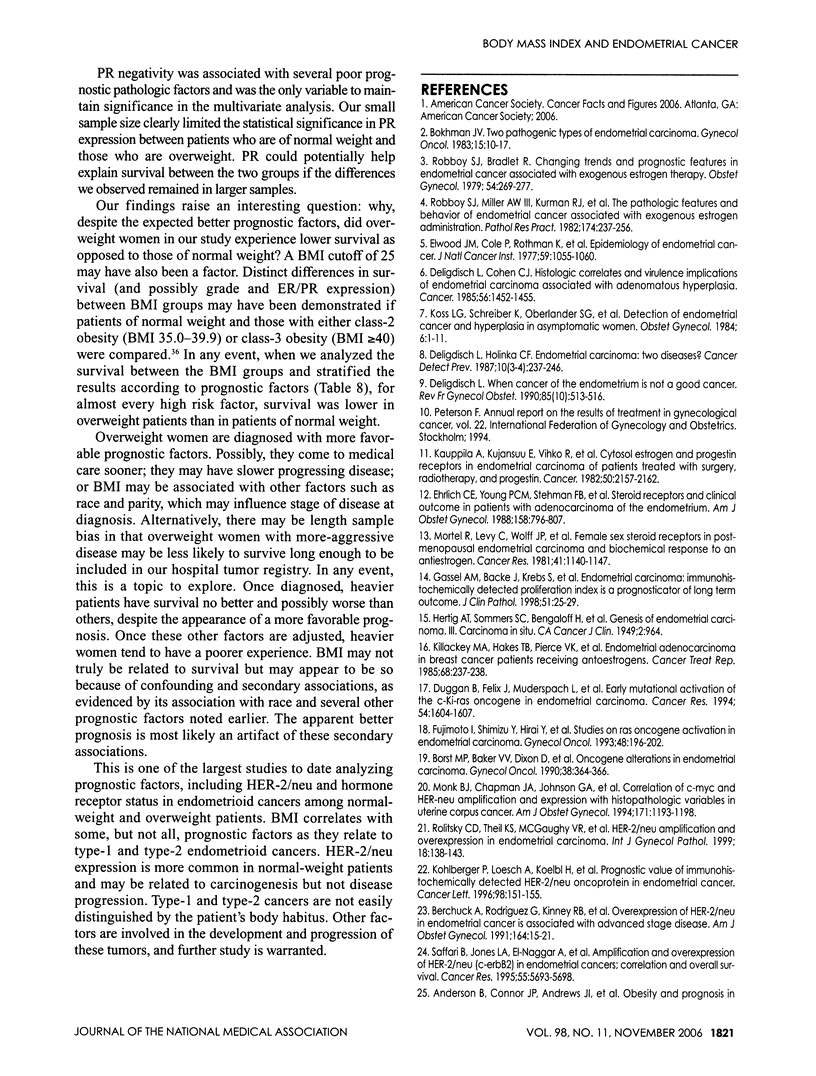
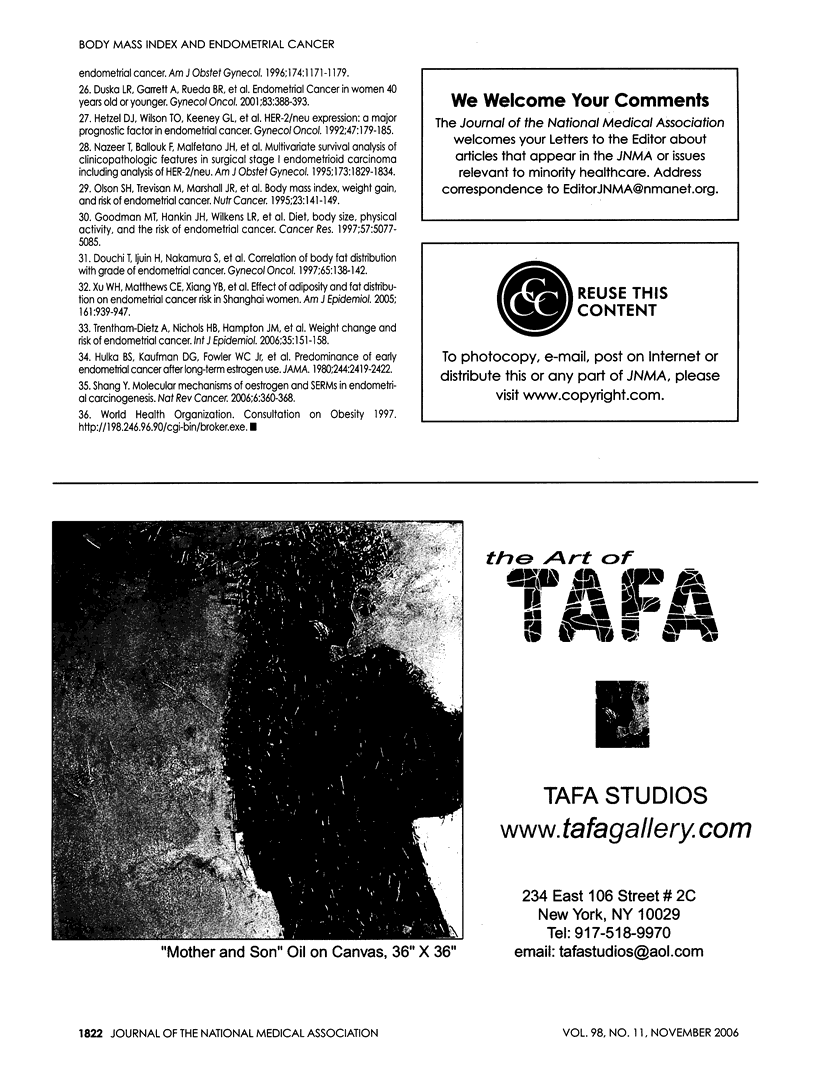
Selected References
These references are in PubMed. This may not be the complete list of references from this article.
- Berchuck A., Rodriguez G., Kinney R. B., Soper J. T., Dodge R. K., Clarke-Pearson D. L., Bast R. C., Jr Overexpression of HER-2/neu in endometrial cancer is associated with advanced stage disease. Am J Obstet Gynecol. 1991 Jan;164(1 Pt 1):15–21. doi: 10.1016/0002-9378(91)90615-x. [DOI] [PubMed] [Google Scholar]
- Bokhman J. V. Two pathogenetic types of endometrial carcinoma. Gynecol Oncol. 1983 Feb;15(1):10–17. doi: 10.1016/0090-8258(83)90111-7. [DOI] [PubMed] [Google Scholar]
- Borst M. P., Baker V. V., Dixon D., Hatch K. D., Shingleton H. M., Miller D. M. Oncogene alterations in endometrial carcinoma. Gynecol Oncol. 1990 Sep;38(3):364–366. doi: 10.1016/0090-8258(90)90074-u. [DOI] [PubMed] [Google Scholar]
- Deligdisch L., Cohen C. J. Histologic correlates and virulence implications of endometrial carcinoma associated with adenomatous hyperplasia. Cancer. 1985 Sep 15;56(6):1452–1455. doi: 10.1002/1097-0142(19850915)56:6<1452::aid-cncr2820560637>3.0.co;2-d. [DOI] [PubMed] [Google Scholar]
- Deligdisch L., Holinka C. F. Endometrial carcinoma: two diseases? Cancer Detect Prev. 1987;10(3-4):237–246. [PubMed] [Google Scholar]
- Deligdisch L. Quand le cancer de l'endomètre n'est pas un bon cancer. Rev Fr Gynecol Obstet. 1990 Oct;85(10):513–516. [PubMed] [Google Scholar]
- Douchi T., Ijuin H., Nakamura S., Oki T., Maruta K., Nagata Y. Correlation of body fat distribution with grade of endometrial cancer. Gynecol Oncol. 1997 Apr;65(1):138–142. doi: 10.1006/gyno.1996.4599. [DOI] [PubMed] [Google Scholar]
- Duggan B. D., Felix J. C., Muderspach L. I., Tsao J. L., Shibata D. K. Early mutational activation of the c-Ki-ras oncogene in endometrial carcinoma. Cancer Res. 1994 Mar 15;54(6):1604–1607. [PubMed] [Google Scholar]
- Duska L. R., Garrett A., Rueda B. R., Haas J., Chang Y., Fuller A. F. Endometrial cancer in women 40 years old or younger. Gynecol Oncol. 2001 Nov;83(2):388–393. doi: 10.1006/gyno.2001.6434. [DOI] [PubMed] [Google Scholar]
- Ehrlich C. E., Young P. C., Stehman F. B., Sutton G. P., Alford W. M. Steroid receptors and clinical outcome in patients with adenocarcinoma of the endometrium. Am J Obstet Gynecol. 1988 Apr;158(4):796–807. doi: 10.1016/0002-9378(88)90075-0. [DOI] [PubMed] [Google Scholar]
- Elwood J. M., Cole P., Rothman K. J., Kaplan S. D. Epidemiology of endometrial cancer. J Natl Cancer Inst. 1977 Oct;59(4):1055–1060. doi: 10.1093/jnci/59.4.1055. [DOI] [PubMed] [Google Scholar]
- Fujimoto I., Shimizu Y., Hirai Y., Chen J. T., Teshima H., Hasumi K., Masubuchi K., Takahashi M. Studies on ras oncogene activation in endometrial carcinoma. Gynecol Oncol. 1993 Feb;48(2):196–202. doi: 10.1006/gyno.1993.1033. [DOI] [PubMed] [Google Scholar]
- Gassel A. M., Backe J., Krebs S., Schön S., Caffier H., Müller-Hermelink H. K. Endometrial carcinoma: immunohistochemically detected proliferation index is a prognosticator of long-term outcome. J Clin Pathol. 1998 Jan;51(1):25–29. doi: 10.1136/jcp.51.1.25. [DOI] [PMC free article] [PubMed] [Google Scholar]
- Goodman M. T., Hankin J. H., Wilkens L. R., Lyu L. C., McDuffie K., Liu L. Q., Kolonel L. N. Diet, body size, physical activity, and the risk of endometrial cancer. Cancer Res. 1997 Nov 15;57(22):5077–5085. [PubMed] [Google Scholar]
- HERTIG A. T., SOMMERS S. C., BENGLOFF H. Genesis of endometrial carcinoma; carcinoma in situ. Cancer. 1949 Nov;2(6):964-71, illust. doi: 10.1002/1097-0142(194911)2:6<964::aid-cncr2820020605>3.0.co;2-b. [DOI] [PubMed] [Google Scholar]
- Hetzel D. J., Wilson T. O., Keeney G. L., Roche P. C., Cha S. S., Podratz K. C. HER-2/neu expression: a major prognostic factor in endometrial cancer. Gynecol Oncol. 1992 Nov;47(2):179–185. doi: 10.1016/0090-8258(92)90103-p. [DOI] [PubMed] [Google Scholar]
- Hulka B. S., Kaufman D. G., Fowler W. C., Jr, Grimson R. C., Greenberg B. G. Predominance of early endometrial cancers after long-term estrogen use. JAMA. 1980 Nov 28;244(21):2419–2422. [PubMed] [Google Scholar]
- Kauppila A., Kujansuu E., Vihko R. Cytosol estrogen and progestin receptors in endometrial carcinoma of patients treated with surgery, radiotherapy, and progestin. Clinical correlates. Cancer. 1982 Nov 15;50(10):2157–2162. doi: 10.1002/1097-0142(19821115)50:10<2157::aid-cncr2820501031>3.0.co;2-7. [DOI] [PubMed] [Google Scholar]
- Killackey M. A., Hakes T. B., Pierce V. K. Endometrial adenocarcinoma in breast cancer patients receiving antiestrogens. Cancer Treat Rep. 1985 Feb;69(2):237–238. [PubMed] [Google Scholar]
- Kohlberger P., Loesch A., Koelbl H., Breitenecker G., Kainz C., Gitsch G. Prognostic value of immunohistochemically detected HER-2/neu oncoprotein in endometrial cancer. Cancer Lett. 1996 Jan 2;98(2):151–155. [PubMed] [Google Scholar]
- Koss L. G., Schreiber K., Oberlander S. G., Moussouris H. F., Lesser M. Detection of endometrial carcinoma and hyperplasia in asymptomatic women. Obstet Gynecol. 1984 Jul;64(1):1–11. [PubMed] [Google Scholar]
- Monk B. J., Chapman J. A., Johnson G. A., Brightman B. K., Wilczynski S. P., Schell M. J., Fan H. Correlation of C-myc and HER-2/neu amplification and expression with histopathologic variables in uterine corpus cancer. Am J Obstet Gynecol. 1994 Nov;171(5):1193–1198. doi: 10.1016/0002-9378(94)90131-7. [DOI] [PubMed] [Google Scholar]
- Mortel R., Levy C., Wolff J. P., Nicolas J. C., Robel P., Baulieu E. E. Female sex steroid receptors in postmenopausal endometrial carcinoma and biochemical response to an antiestrogen. Cancer Res. 1981 Mar;41(3):1140–1147. [PubMed] [Google Scholar]
- Nazeer T., Ballouk F., Malfetano J. H., Figge H., Ambros R. A. Multivariate survival analysis of clinicopathologic features in surgical stage I endometrioid carcinoma including analysis of HER-2/neu expression. Am J Obstet Gynecol. 1995 Dec;173(6):1829–1834. doi: 10.1016/0002-9378(95)90436-0. [DOI] [PubMed] [Google Scholar]
- Olson S. H., Trevisan M., Marshall J. R., Graham S., Zielezny M., Vena J. E., Hellmann R., Freudenheim J. L. Body mass index, weight gain, and risk of endometrial cancer. Nutr Cancer. 1995;23(2):141–149. doi: 10.1080/01635589509514370. [DOI] [PubMed] [Google Scholar]
- Robboy S. J., Bradley R. Changing trends and prognostic features in endometrial cancer associated with exogenous estrogen therapy. Obstet Gynecol. 1979 Sep;54(3):269–277. [PubMed] [Google Scholar]
- Robboy S. J., Miller A. W., 3rd, Kurman R. J. The pathologic features and behavior of endometrial carcinoma associated with exogenous estrogen administration. Pathol Res Pract. 1982 Aug;174(3):237–256. doi: 10.1016/S0344-0338(82)80069-1. [DOI] [PubMed] [Google Scholar]
- Rolitsky C. D., Theil K. S., McGaughy V. R., Copeland L. J., Niemann T. H. HER-2/neu amplification and overexpression in endometrial carcinoma. Int J Gynecol Pathol. 1999 Apr;18(2):138–143. doi: 10.1097/00004347-199904000-00007. [DOI] [PubMed] [Google Scholar]
- Saffari B., Jones L. A., el-Naggar A., Felix J. C., George J., Press M. F. Amplification and overexpression of HER-2/neu (c-erbB2) in endometrial cancers: correlation with overall survival. Cancer Res. 1995 Dec 1;55(23):5693–5698. [PubMed] [Google Scholar]
- Shang Yongfeng. Molecular mechanisms of oestrogen and SERMs in endometrial carcinogenesis. Nat Rev Cancer. 2006 May;6(5):360–368. doi: 10.1038/nrc1879. [DOI] [PubMed] [Google Scholar]
- Trentham-Dietz A., Nichols H. B., Hampton J. M., Newcomb P. A. Weight change and risk of endometrial cancer. Int J Epidemiol. 2005 Nov 8;35(1):151–158. doi: 10.1093/ije/dyi226. [DOI] [PubMed] [Google Scholar]
- Xu Wang Hong, Matthews Charles E., Xiang Yong Bing, Zheng Wei, Ruan Zhi Xian, Cheng Jia Rong, Gao Yu Tang, Shu Xiao Ou. Effect of adiposity and fat distribution on endometrial cancer risk in Shanghai women. Am J Epidemiol. 2005 May 15;161(10):939–947. doi: 10.1093/aje/kwi127. [DOI] [PubMed] [Google Scholar]


